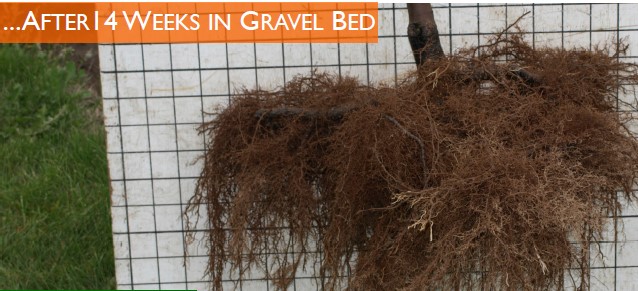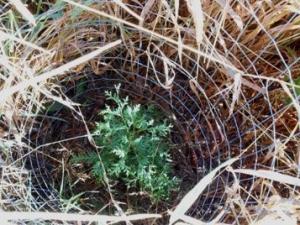What's Working for Conservation
Forest Establishment
2020 Information
Forestry Mower: We mostly stick with winter mowing, when it will have least impact on the native species. Our comparisons were regular hand-cut & treat, forestry mow along, forestry mow followed right away by treating larger stumps, and 2 yrs forestry mow. One of our biggest takeaways was the manner of forestry mowing is key - the mower has to get to the soil surface to be able to disrupt the root collar as much as possible, and the mower has to go back and forth to chew up the stump and not leave tall sticks and heavy debris. So mowing when there is a lot of snow or if there is a layer of ice below the snow does not work as well. (Karen Schik, Friends of the Mississippi River)
2016 Information
Planting in Grasslands: When planting trees into a grassland (in this case a reed-canary grassland), we hand pulled grass in the tree location and tacked weed barrier fabric around each tree. We used TALL bareroot trees (5-6 ft), which were above deer browse height. All that worked well, but what we did not account for was the amount of vole activity. They girdled most of the trunks. We did have tree protectors (the coiled flat plastic type that goes around the trunk) on some trees and that worked very well. So in planting a grassland, you need to protect from deer AND voles. This is mainly an issue in dense grassland areas, as we have not had that problem in less grassy areas. Or if the planting area could be mowed, that would probably do the trick. This site was not accessible for equipment, so we were looking for the most effective method with the least amount of site prep. (Karen Schik, Friends of the Mississippi River)
Gravel Beds: Gravel bed nurseries are beds of pea gravel that have been used to grow roots on bare root nursery stock. The gravel beds are irrigated daily, typically for 10 to 15 minutes. Watering is automated with a timer and applied through a drip or soaker hose.
Gary Johnson at the University of Minnesota’s Department of Forest Resources has worked with communities across the state to install gravel beds to help communities lower their tree purchase costs and extend the planting season. For example a bare root ‘liner’ is a fraction of the cost of balled and burlapped nursery stock. Liner stock is placed in the gravel bed. The irrigated gravel encourages root development on many species. With expanded root development many species can be planted in full leaf.
Gravel Beds: The use of gravel beds to hold and grow roots on seedling nursery stock was demonstrated at Cloquet Forestry Center, Wolf Ridge Learning and Environmental Center and Boulder Lake Learning and Environmental Centers. See Figure 1. After 2 months in the gravel bed many species of seedling trees exhibited exceptional root development. Early fall planting of these trees has been successful. In addition, several landowners have installed small versions of the gravel bed to “heel in” their seedlings to extend the planting season. Many landowners buy trees through the local Soil and Water Conservation District Tree sales and plant them while visiting their woodland. Use of the gravel bed nursery may provide landowners to spread the planting of seedlings over several weekends or even hold the trees for planting in late summer or early fall. (Mike Reichenbach, University of Minnesota Extension)
2015 Information
Tree Mats: Growing cedar trees in reed canary grass is one of the greatest challenges of tree planting. I found that use of tree mats combined with wire cages is an extremely successful method. The mats keep the grass under control, the cages keep overtopping grass from choking-out the trees and they prevent browse damage, and the surrounding dense cover provides ideal micro-site conditions favorable for optimum tree vigor. Depending on planting density, this method is more cost-effective than using extensive site prep. Imagine that. We can grow one of the most difficult species in some of the most difficult site conditions. It works (Jerry Stensing, Trees Minnesota, TreesMn.com)!
Fencing for Deer: This is a technique that can be employed to keep deer from killing your planted trees (sapling size) at a restoration site. Although deer can cause major damage to these young trees by browsing on the young leaves and defoliating them, the biggest damage is usually done by bucks rubbing the trunks and girdling them. Here is what we did to combat this problem: Construct a deer prevention fence around the entire perimeter of your site. Construct the fence with a 2-strand electric wire powered by a solar fencer (or AC powered fencer if possible). Fasten sheet metal plates to the two wire strands approximately every 100 feet. Bait the plates with peanut butter which the deer lick, get shocked and are thus trained to stay out of the fenced area. This technique requires fairly intensive maintenance (keeping fencelines mowed so weeds don’t short it out, fixing fence when necessary, checking to make sure fencer is working, re-baiting and re-attaching plates) but is effective. We did this at two sites and had the fences up for two growing seasons after which they were removed because they were no longer necessary (Mike Graham, Wenck Associates Inc.).


